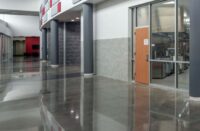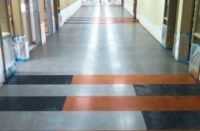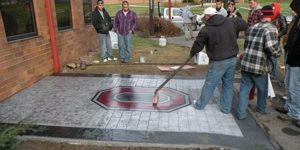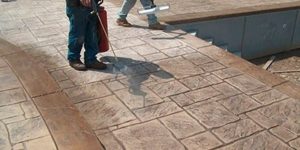At a recent strategic planning meeting of the Concrete Polishing Association of America, the board of directors and active committee members met to help lead, develop and guide our future. The hottest topic was the presentation on standards for polished concrete. A most welcome surprise was the evidence that properly polished concrete is one of the safest flooring choices available to the consumer.
This revelation came out of CPAA-sponsored field workshops where a battery of tests was performed, including measurements of dynamic coefficient of friction (DCOF). It was determined that people walking on polished concrete floors will slip less often than those on almost any other floor. These preliminary tests provide a unique and compelling marketing opportunity.
According to data compiled by the National Floor Safety Institute, slip, trip and fall accidents result in more than 8 million emergency room visits per year, often with resulting litigation and damage awards. The NFSI reports that the financial impact of these accidents exceeds $80 billion per year. With education and skills development, concrete polishers can help reduce these numbers and directly make an impact on profitability. This one item can exponentially launch the demand for polished concrete!
The use of polished concrete has grown dramatically, primarily in the retail and education sectors. Growth has been driven by the low life-cycle cost. The industry can build on this momentum by developing a specific polished concrete standard that allows us to measure and thus prove that polished concrete is the safest flooring option.
Many of us have known this all along. Research shows that the incidence of slip accidents can be reduced by 21 percent with every 0.1 increase in measured COF, and floor traction has a much larger influence on slipping than awareness or behavior.
Measuring the coeefficient of friction
Let’s look closer at coefficient of friction. What is COF, and why does it matter to concrete polishers and our clients? When a client or general contractor asks for a certain COF value, how can we respond? What are the best ways to measure and document COF?
COF values are used to define the slip resistance of particular types of walkway surfaces when subjected to dry and wet conditions. The two types of COF measurement are static (SCOF) and dynamic (DCOF). SCOF refers to how much force is required to get an object to budge, move or slip. DCOF refers to how much force is required to keep an object in motion or slide at a constant velocity. (A simple trick to remember the difference is the S in SCOF is standing still, while the D in DCOF is dancing.)
Historically, SCOF testing has been more common in the United States, while DCOF is more prevalent worldwide. While SCOF is still being used in the United States, this is changing as DCOF becomes recognized as the true and accurate measurement result for predicting slip-and-fall risk.
The American National Standards Institute (ANSI) has adopted three COF standards since 2009:
- ANSI B101.1 is a wet static measurement test written by the National Floor Safety Institute (NFSI).
- ANSI B101.3 is a wet dynamic measurement, also written by the NSFI.
- ANSI A137-1-2012 specifies methodology for DCOF testing of wet tile. The Tile Council of North America (TCNA) wrote this standard.
These recent standards are part of the effort to define what constitutes a high-traction floor.
Tribology is the study of friction, lubrication, adhesion and wear. Tribometers measure friction between two rubbing surfaces and are the instruments used to measure walkway slip resistance under these three ANSI standards. Many tribometers can measure several factors of two rubbing surfaces, including coefficient of friction, friction force and wear volume. This funny word comes from the Greek word “tribein,” meaning “to rub,” plus “meter” for measurement.
(A fun fact about the “tribo” root is that it is also seen in “triboluminescence,” which is the spark seen when Wint O Green Life Savers are crunched in the dark. As the hard candy is chewed, crystalline sugars are crushed and “rubbed” against each other. The rubbing causes electrons to be thrown out of their atomic orbits, where they bump against nitrogen molecules in the air, which shed this excess energy by emitting light.)
Walkway slip resistance under these recent ANSI standards can be measured with a tribometer (or slip meter) and categorized into one of three traction ranges, based on a scale of 0.0 to 1.0. Since static and dynamic COF measure somewhat different things, the traction ranges for each are slightly different.

Floors with a high traction rating present a low risk of slip and fall, while those with moderate and low traction present elevated risk for slips, trips and falls. The appropriate levels of slip resistance for a particular type of surface depend on the risk assessment of the material manufacturer and owner of the installed walkway. For example, the Tile Council of North America requires a minimum DCOF value of 0.42 for ceramic floors to be walked on wet.
Interestingly, the initial results of the CPAA workshops indicate that a wide array of polished concrete finishes provide wet DCOF measurements of 0.50 and higher, well above what is considered to be high traction.
How can we use these measurements for polished concrete floors? The best way is for concrete polishers to begin measuring and confirming the improvements in COF.
Select and use a tribometer according to these four criteria:
- Ease of use
- Validation and repeatability
- Ease of transport to field sites
- Supplier service and support
The BOT-3000E digital tribometer from Regan Scientific is gaining wide use among flooring contractors, facility owners and concrete polishers. It meets the four selection criteria and can be used to measure all three ANSI standards.
A tribometer will allow the contractor to document that a floor meets a specification or request for a certain COF value, providing peace of mind that the floor can help reduce the frequency of slips and falls. The customer (architect, general contractor or owner) can rely on the numbers and enjoy the security of knowing that our properly polished concrete floors will actually “grip” as people step across the surface.
Cleaning is essential
We cannot overlook the importance of proper maintenance of polished concrete floors. This area of service must be more thoroughly addressed. Insurance carrier CNA has published a report that points to contamination on floors as a major contributor to slips, trips and falls. A study by the U.S. government showed a contaminated (dirty) floor to be 17 times more likely than a clean floor to cause a slip-fall accident. Even a properly prepared surface (not slippery when wet) will become contaminated and slippery when inadequately maintained. However, when polished concrete is properly polished, properly tested for COF, and properly maintained, it just might be the safest floor yet!
Since the CPAA Polished Concrete Definitions were established last year, there is greater understanding and less confusion about the appearance and performance characteristics of properly polished concrete. The Standards & Specifications Committee of the CPAA is currently in the process of testing, evaluating, and writing the Polished Concrete Standard for COF (specifically using wet DCOF methodology). The goal is to develop a consensus standard for accuracy, repeatability and reproducibility. When completed, this consensus standard will document the findings that we currently see among those of us who perform COF testing. A standard for COF will exponentially benefit our industry. In the meantime, we can educate ourselves on the test methods available and learn to perform them accurately. I can’t wait until we can insert the COF consensus standard into polished concrete specifications. This will be a game-changer.















